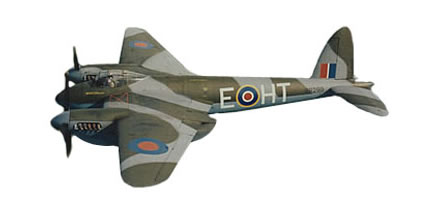de Havilland Mosquito TT35
| Serial No: | TA639 |
| Period: | WWII |
| Reference: | 67/A/595 |
| Museum: | Midlands |
| Location: | War in the Air |
| On Display: | Yes |
The Mosquito was a remarkable aircraft for its time; not only was it made largely of wood but it was designed as an unarmed bomber relying on its superior speed to escape enemy fighters. It was nicknamed ‘The Wooden Wonder’.
Design work began in December 1939 and the prototype first flew less than eleven months later. During the war the Mosquito earned a distinguished reputation as a bomber, being used by No.2 Group in a series of low level attacks. Other bomber variants were used in night attacks on industrial targets and for target marking. Coastal Command’s Strike Wings used the Mosquito’s formidable firepower in rocket attacks on enemy shipping and fighter variants defended the United Kingdom and supported Bomber Command by attacking German night fighters. High flying Mosquitoes of the RAF and USAAF undertook photographic reconnaissance sorties and a small number were operated by the British Overseas Airways Corporation to carry urgently needed supplies between Britain and Sweden during World War II.
Over seven thousand Mosquitos were built in Britain, Australia and Canada. After the war they continued in use as fighters until 1952 and others, including this example , were converted to tow targets for anti aircraft gunnery practice.






